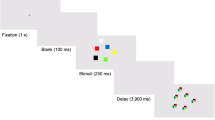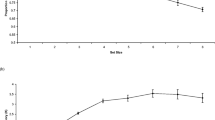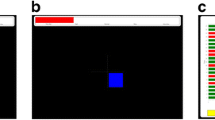Abstract
We used pupillometry during a 2-back task to examine individual differences in the intensity and consistency of attention and their relative role in a working memory task. We used sensitivity, or the ability to distinguish targets (2-back matches) and nontargets, as the measure of task performance; task-evoked pupillary responses (TEPRs) as the measure of attentional intensity; and intraindividual pretrial pupil variability as the measure of attentional consistency. TEPRs were greater on target trials compared with nontarget trials, although there was no difference in TEPR magnitude when participants answered correctly or incorrectly to targets. Importantly, this effect interacted with performance: high performers showed a greater separation in their TEPRs between targets and nontargets, whereas there was little difference for low performers. Further, in regression analysis, larger TEPRs on target trials predicted better performance, whereas larger TEPRs on nontarget trials predicted worse performance. Sensitivity positively correlated with average pretrial pupil diameter and negatively correlated with intraindividual variability in pretrial pupil diameter. Overall, we found evidence that both attentional intensity (TEPRs) and consistency (pretrial pupil variation) predict performance on an n-back working memory task.



Similar content being viewed by others
Data Availability
All preprocessing and analysis scripts are publicly available on the Open Science Framework (https://osf.io/eacu5/).
Notes
We used a listwise deletion procedure here rather than pairwise deletion since all dependent variables were collected during the same task. However, if we perform pairwise deletion, the pattern of results is largely identical.
These criteria were not preregistered but are consistent with prior work. To verify the exclusions did not impact the results, we reran the analysis with a series of exclusion criteria ranging in conservativeness and they were qualitatively similar.
References
Ackerman, P. L., Beier, M. E., & Boyle, M. O. (2005). Working memory and intelligence: The same or different constructs? Psychological Bulletin, 131(1), 30–60. https://doi.org/10.1037/0033-2909.131.1.30
Aminihajibashi, S., Hagen, T., Andreassen, O. A., Laeng, B., & Espeseth, T. (2020). The effects of cognitive abilities and task demands on tonic and phasic pupil sizes. Biological Psychology, 156, Article 107945. https://doi.org/10.1016/j.biopsycho.2020.107945
Baddeley, A. D., & Hitch, G. (1974). Working memory. Psychology of Learning and Motivation, 8, 47–89. https://doi.org/10.1016/s0079-7421(08)60452-1
Beatty, J., & Lucero-Wagoner, B. (2000). In J. T. Cacioppo, L. G. Tassinary, & G. G. Berntson (Eds.), Handbook of psychophysiology (2nd ed., pp. 142–162). Cambridge University Press.
Callicott, J. H., Mattay, V. S., Bertolino, A., Finn, K., Coppola, R., Frank, J. A., Goldberg, T. E., & Weinberger, D. R. (1999). Physiological characteristics of capacity constraints in working memory as revealed by functional MRI. Cerebral Cortex, 9(1), 20–26. https://doi.org/10.1093/cercor/9.1.20
Cowan, N. (2001). The magical number 4 in short-term memory: A reconsideration of mental storage capacity. Behavioral and Brain Sciences, 24(1), 87–114. https://doi.org/10.1017/S0140525X01003922
Dalmaijer, E. S., Mathôt, S., & Van der Stigchel, S. (2014). PyGaze: An open-source, cross-platform toolbox for minimal-effort programming of eyetracking experiments. Behavior Research Methods, 46, 913–921. https://doi.org/10.3758/s13428-013-0422-2
Dong, S., Reder, L. M., Yao, Y., Liu, Y., & Chen, F. (2015). Individual differences in working memory capacity are reflected in different ERP and EEG patterns to task difficulty. Brain Research, 1616, 146–156. https://doi.org/10.1016/j.brainres.2015.05.003
Dowle, M., & Srinivasan, A. (2019). Package ‘data.table: Extension of ‘data.frame’ (R package Version 1.14.2) [Computer software]. https://CRAN.R-project.org/package=data.table. Accessed 29 Aug 2023.
Emch, M., Von Bastian, C. C., & Koch, K. (2019). Neural correlates of verbal working memory: An fMRI meta-analysis. Frontiers in Human Neuroscience, 13, 180. https://doi.org/10.3389/fnhum.2019.00180
Engle, R. W., Tuholski, S. W., Laughlin, J. E., & Conway, A. R. (1999). Working memory, short-term memory, and general fluid intelligence: A latent-variable approach. Journal of Experimental Psychology: General, 128(3), 309–331. https://doi.org/10.1037/0096-3445.128.3.309
Fietz, J., Pöhlchen, D., Binder, F. P., Czisch, M., Sämann, P. G., & Spoormaker, V. I. (2021). Pupillometry tracks cognitive load and salience network activity in a working memory functional magnetic resonance imaging task. Human Brain Mapping, 43(2), 665–680. https://doi.org/10.1002/hbm.25678
Hedge, C., Powell, G., & Sumner, P. (2018). The reliability paradox: Why robust cognitive tasks do not produce reliable individual differences. Behavior Research Methods, 50, 1166–1186. https://doi.org/10.3758/s13428-017-0935-1
Hess, E. H., & Polt, J. M. (1964). Pupil size in relation to mental activity during simple problem-solving. Science, 143(3611), 1190–1192. https://doi.org/10.1126/science.143.3611.1190
Hockey, R. (2013). The psychology of fatigue: Work, effort and control. Cambridge University Press.
Hopstaken, J. F., Van Der Linden, D., Bakker, A. B., & Kompier, M. A. J. (2015). The window of my eyes: Task disengagement and mental fatigue covary with pupil dynamics. Biological Psychology, 110, 100–106. https://doi.org/10.1016/j.biopsycho.2015.06.013
Kahneman, D. (1973). Attention and effort. Prentice-Hall.
Kahneman, D., & Beatty, J. (1966). Pupil diameter and load on memory. Science, 154(3756), 1583–1585. https://doi.org/10.1126/science.154.3756.1583
Kane, M. J., Bleckley, M. K., Conway, A. R., & Engle, R. W. (2001). A controlled-attention view of working-memory capacity. Journal of Experimental Psychology: General, 130(2), 169–183. https://doi.org/10.1037/0096-3445.130.2.169
Kane, M. J., Conway, R. A., Miura, T. K., & Colflesh, G. J. (2007). Working memory, attention control, and the N-back task: A question of construct validity. Journal of Experimental Psychology: Learning, Memory, and Cognition, 33(3), 615–622. https://doi.org/10.1037/0278-7393.33.3.615
Kanfer, R., & Ackerman, P. L. (1989). Motivation and cognitive abilities: An integrative/aptitude-treatment interaction approach to skill acquisition. Journal of Applied Psychology, 74(4), 657. https://doi.org/10.1037/0021-9010.74.4.657
Kassambara, A. (2023). rstatix: Pipe-friendly framework for basic statistical tests (R package version 0.7.2) [Computer software]. https://CRAN.R-project.org/package=rstatix. Accessed 29 Aug 2023.
Madore, K. P., & Wagner, A. D. (2022). Readiness to remember: Predicting variability in episodic memory. Trends in Cognitive Sciences. https://doi.org/10.1016/j.tics.2022.05.006
Mathôt, S., Fabius, J., Van Heusden, E., & Van der Stigchel, S. (2018). Safe and sensible preprocessing and baseline correction of pupil-size data. Behavior Research Methods, 50, 94–106. https://doi.org/10.3758/s13428-017-1007-2
Miller, A. L., & Unsworth, N. (2020). Variation in attention at encoding: Insights from pupillometry and eye gaze fixations. Journal of Experimental Psychology: Learning, Memory & Cognition, 46(12), 2277–2294. https://doi.org/10.1037/xlm0000797
Miller, A. L., & Unsworth, N. (2021). Attending to encode: The role of consistency and intensity of attention in learning ability. Journal of Memory and Language, 121, Article 104276. https://doi.org/10.1016/j.jml.2021.104276
Miller, A. L., Gross, M. P., & Unsworth, N. (2019). Individual differences in working memory capacity and long-term memory: The influence of intensity of attention to items at encoding as measured by pupi dilation. Journal of Memory and Language, 104, 25–42. https://doi.org/10.1016/j.jml.2018.09.005
R Core Team. (2022). R: A language and environment for statistical computing [Computer software]. R Foundation for Statistical Computing. https://www.R-project.org/. Accessed 29 Aug 2023.
Redick, T. S., & Lindsey, D. R. (2013). Complex span and n-back measures of working memory: A meta-analysis. Psychonomic Bulletin & Review, 20, 1102–1113. https://doi.org/10.3758/s13423-013-0453-9
Revelle, W. (2022). psych: Procedures for personality and psychological research (R package Version 2.2.5) [Computer software]. https://CRAN.R-project.org/package=psych. Accessed 29 Aug 2023.
Robison, M. K., & Brewer, G. A. (2020). Individual differences in working memory capacity and the regulation of arousal. Attention, Perception, & Psychophysics, 82, 3273–3290. https://doi.org/10.3758/s13414-020-02077-0
Robison, M. K., & Brewer, G. (2022). Individual differences in working memory capacity, attention control, fluid intelligence, and pupillary measures of arousal. Journal of Experimental Psychology: Learning, Memory, and Cognition, 48(9), 1296–1310. https://doi.org/10.1037/xlm0001125
Robison, M. K., & Unsworth, N. (2019). Pupillometry tracks fluctuations in working memory performance. Attention, Perception, & Psychophysics, 81(2), 407–419. https://doi.org/10.3758/s13414-018-1618-4
Robison, M. K., Trost, J. M., Schor, D., Gibson, B. S., & Healey, M. K. (2022). Pupillary correlates of individual differences in long-term memory. Psychonomin Bulletin & Review, 29, 1355–1366. https://doi.org/10.3758/s13423-022-02081-5
Robison, M. K., Ralph, K. J., Gondoli, D. M., Torres, A., Campbell, S., Brewer, G. A., & Gibson, B. S. (2023). Testing locus coeruleus-norepinephrine accounts of working memory, attention control, and fluid intelligence. Cognitive, Affective, & Behavioral Neuroscience, 1–45. Advance online publication. https://doi.org/10.3758/s13415-023-01096-2
Rondeel, E. W., van, Steenbergen, H., Holland, R. W., & van Knippenberg, A. (2015). A closer look at cognitive control: Differences in resource allocation during updating, inhibition and switching as revealed by pupillometry. Frontiers in Human Neuroscience, 9. https://doi.org/10.3389/fnhum.2015.00494
Schmiedek, F., Lövdén, M., & Lindenberger, U. (2014). A task is a task is a task: Putting complex span, n-back, and other working memory indicators in psychometric context. Frontiers in Psychology, 5, Article 1475. https://doi.org/10.3389/fpsyg.2014.01475
Schmiedek, F., Hildebrandt, A., Lövdén, M., Wilhelm, O., & Lindenberger, U. (2009). Complex span versus updating tasks of working memory: The gap is not that deep. Journal of Experimental Psychology: Learning, Memory, and Cognition, 35(4), 1089–1096. https://psycnet.apa.org/doi/10.1037/a0015730
Schönbrodt, F. D. & Perugini, M. (2013). At what sample size do correlations stabilize? Journal of Research in Personality, 47(5), 609–612. https://doi.org/10.1016/j.jrp.2013.05.009
Snodgrass, J. G., & Corwin, J. (1988). Pragmatics of measuring recognition memory: Applications to dementia and amnesia. Journal of Experimental Psychology: General, 117(1), 34. https://doi.org/10.1037/0096-3445.117.1.34
Unsworth, N., & Miller, A. L. (2021). Individual differences in the intensity and consistency of attention. Current Directions in Psychological Science, 30(5), 391–400. https://doi.org/10.1177/09637214211030266
Unsworth, N., & Miller, A. L. (2023). Pupillary correlates of preparatory control in the Stroop task. Attention, Perception, & Psychophysics, 1–19. https://doi.org/10.3758/s13414-023-02751-z
Unsworth, N., & Robison, M. K. (2015). Individual differences in the allocation of attention to items in working memory: Evidence from pupillometry. Psychonomic Bulletin & Review, 22(3), 757–765. https://doi.org/10.3758/s13423-014-0747-6
Unsworth, N., & Robison, M. K. (2017a). A locus coeruleus-norepinephrine account of individual differences in working memory capacity and attention control. Psychonomic Bulletin & Review, 24(4), 1282–1311. https://doi.org/10.3758/s13423-016-1220-5
Unsworth, N., & Robison, M. K. (2017b). The importance of arousal for variation in working memory capacity and attention control: A latent variable pupillometry study. Journal of Experimental Psychology: Learning, Memory, and Cognition, 43(12), 1962. https://doi.org/10.1037/xlm0000421
Unsworth, N., & Robison, M. K. (2018). Tracking working memory maintenance with pupillometry. Attention, Perception, & Psychophysics, 80(2), 461–484. https://doi.org/10.3758/s13414-017-1455-x
Unsworth, N. & Spillers, G. J. (2010) Working memory capacity: Attention control secondary memory or both? A direct test of the dual-component model. Journal of Memory and Language, 62(4), 392–406. https://doi.org/10.1016/j.jml.2010.02.001
Unsworth, N., Fukuda, K., Awh, E., & Vogel, E. K. (2014). Working memory and fluid intelligence: Capacity, attention control, and secondary memory retrieval. Cognitive Psychology, 71, 1–26. https://doi.org/10.1016/j.cogpsych.2014.01.003
Unsworth, N., Miller, A. L., & Robison, M. K. (2020). Individual differences in lapses of sustained attention: Ocolumetric indicators of intrinsic alertness. Journal of Experimental Psychology: Human Perception and Performance, 46(6), 569–592. https://doi.org/10.1037/xhp0000734
Wickham, H. (2016). ggplot2: Elegant graphics for data analysis. Springer. https://doi.org/10.1007/978-0-387-98141-3
Wickham, H., Averick, M., Bryan, J., Chang, W., McGowan, L. D. A., François, R., Grolemund, G., Hayes, A., Henry, L., Hester, J., Kuhn, M., Pedersen, T. L., Miller, E., Bache, S. M., Müller, K., Ooms, J., Robinson, D., Seidel, D. P., & Spinu, V., … Yutani, H. (2019). Welcome to the tidyverse. Journal of Open Source Software, 4(43), 1686. https://doi.org/10.21105/joss.01686
Wilke, C. (2020). cowplot: Streamlined plot theme and plot annotations for ‘ggplot2’ (R package Version 1.1.1) [Computer software]. https://CRAN.R-project.org/package=cowplot. Accessed 29 Aug 2023.
Yeung, M. K., LeeT., L., Han, Y. M. Y., & Chan, A. S. (2021). Prefrontal activation and pupil dilation during N-Back Task Performance: A combined fNIRS and pupillometry study. Neuropsychologia, 159(107954). https://doi.org/10.1016/j.neuropsychologia.2021.107954
Author note
The authors were supported by collaborative agreements with the U.S. Naval Research Laboratory (N00173-22-2-C006) and U.S. Army Research Institute (W911NF-23-1-0300).
Author information
Authors and Affiliations
Corresponding author
Additional information
Publisher's Note
Springer Nature remains neutral with regard to jurisdictional claims in published maps and institutional affiliations.
Rights and permissions
Springer Nature or its licensor (e.g. a society or other partner) holds exclusive rights to this article under a publishing agreement with the author(s) or other rightsholder(s); author self-archiving of the accepted manuscript version of this article is solely governed by the terms of such publishing agreement and applicable law.
About this article
Cite this article
Robison, M.K., Garner, L.D. Pupillary correlates of individual differences in n-back task performance. Atten Percept Psychophys 86, 799–807 (2024). https://doi.org/10.3758/s13414-024-02853-2
Accepted:
Published:
Issue Date:
DOI: https://doi.org/10.3758/s13414-024-02853-2




